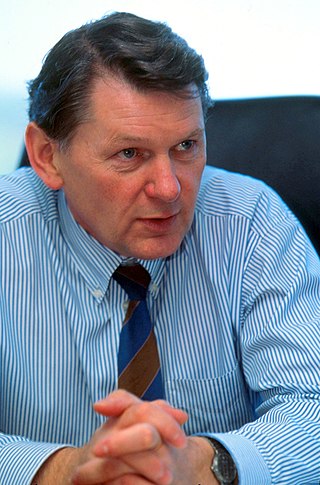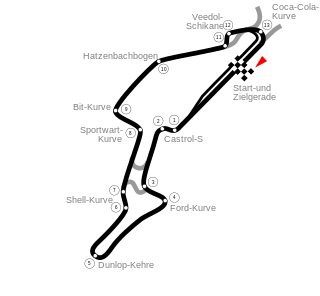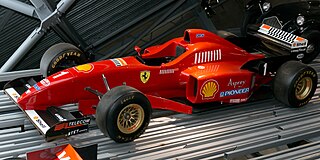
Gerhard Berger is an Austrian former Formula One racing driver. He competed in Formula One for 14 seasons, twice finishing 3rd overall in the championship, both times driving for Ferrari. He won ten Grands Prix, achieved 48 podiums, 12 poles and 21 fastest laps.

John Edward Barnard, is an English engineer and racing car designer. Barnard is credited with the introduction of two new designs into Formula One: the carbon fibre composite chassis first seen in 1981 with McLaren, and the semi-automatic gearbox which he introduced with Ferrari in 1989.

The 1995 European Grand Prix was a Formula One motor race held on 1 October 1995 at the Nürburgring, Nürburg, Germany. It was the fourteenth race of the 1995 Formula One World Championship and the first to be held there since 1985. Michael Schumacher for the Benetton team won the 67-lap race starting from third position. Jean Alesi finished second in a Ferrari, with David Coulthard, who started the Grand Prix from pole position, third in a Williams car. This was also the last F1 race for three drivers: Massimiliano Papis, Gabriele Tarquini and Jean-Denis Délétraz.

The 1995 Australian Grand Prix was a Formula One motor race held on 12 November 1995 at the Adelaide Street Circuit, Adelaide. The race, contested over 81 laps, was the seventeenth and final race of the 1995 Formula One season, and the eleventh and last Australian Grand Prix to be held at Adelaide before the event moved to Melbourne the following year. This would also prove to be the last Grand Prix for Mark Blundell, Bertrand Gachot, Roberto Moreno, Taki Inoue, Karl Wendlinger. This was also the last race for Pacific as they folded at the end of the season.

The 1997 FIA Formula One World Championship was the 51st season of FIA Formula One motor racing. It featured the 1997 Formula One World Championship for Drivers and the 1997 Formula One World Championship for Constructors, which were contested concurrently over a seventeen-race series that commenced on 9 March and ended on 26 October.

The 1996 FIA Formula One World Championship was the 50th season of FIA Formula One motor racing. The championship commenced on 10 March and ended on 13 October after sixteen races. Two World Championship titles were awarded, one for Drivers and one for Constructors.

The 1995 FIA Formula One World Championship was the 49th season of FIA Formula One motor racing. It featured the 1995 Formula One World Championship for Drivers and the 1995 Formula One World Championship for Constructors, which were contested concurrently over a seventeen-race series that commenced on 26 March and ended on 12 November.

The 1994 FIA Formula One World Championship was the 48th season of FIA Formula One motor racing. It featured the 1994 Formula One World Championship for Drivers and the 1994 Formula One World Championship for Constructors, which were contested concurrently over a sixteen-race series that commenced on 27 March and ended on 13 November.

The 1993 FIA Formula One World Championship was the 47th season of FIA Formula One motor racing. It featured the 1993 Formula One World Championship for Drivers and the 1993 Formula One World Championship for Constructors, which were contested concurrently over a sixteen-race series that commenced on 14 March and ended on 7 November. Alain Prost won his fourth and final Drivers' Championship. As of 2023, this is the last championship for a French Formula One driver.

The 1992 Formula One World Championship was the 46th season of FIA Formula One motor racing. It featured the 1992 Formula One World Championship for Drivers and the 1992 Formula One World Championship for Constructors, which were contested concurrently over a sixteen-race series that commenced on 1 March and ended on 8 November. Nigel Mansell won the Drivers' Championship and Williams-Renault won the Constructors' Championship.

The 1991 FIA Formula One World Championship was the 45th season of FIA Formula One motor racing and the 42nd season of the Formula One World Championship. It featured the 1991 Formula One World Championship for Drivers and the 1991 Formula One World Championship for Constructors, which were contested concurrently over a sixteen-race series that commenced on 10 March and ended on 3 November.

The McLaren MP4/5, and its derived sister model, the McLaren MP4/5B, were highly successful Formula One racing cars designed by the McLaren Formula One team based in Woking, England, and powered by Honda's naturally-aspirated RA109E and RA100E V10 engines respectively. The chassis design was led by Neil Oatley, teaming up with Steve Nichols, Pete Weismann, Tim Wright, Bob Bell and Mike Gascoyne. As with the previous designs, Gordon Murray, as Technical Director, had the role of liaising between the drawing office and production. Osamu Goto was the Honda F1 team chief designer for the car's engine.

The Williams FW18, also known as the Williams-Renault FW18, is one of the most successful Formula One car designs of all time. It was designed by Adrian Newey and Patrick Head for the Williams F1 team for the 1996 Formula One season.

The Ferrari 640 was the Formula One racing car with which the Ferrari team competed in the 1989 Formula One World Championship. It was driven by Britain's Nigel Mansell, in his first season with the team, and Austria's Gerhard Berger, winning three races between them. An early version known as the 639 is the basis of the 640 and has the same name F1-89.

The Ferrari F310, and its evolution, the F310B, were the Formula One racing cars with which the Ferrari team competed in the 1996 and 1997 seasons. It was driven in both years by Michael Schumacher, who was swapped with Benetton in favour of Jean Alesi and Eddie Irvine.

The Ferrari 641 was the Formula One racing car with which the Ferrari team competed in the 1990 Formula One World Championship. Driven by Alain Prost and Nigel Mansell, it won six Grands Prix.

The Ferrari F1/87 is a Formula One racing car used by the Ferrari team during the 1987 Formula One season. The car was driven by Michele Alboreto and Gerhard Berger and replaced the Ferrari F1/86 used in 1986.

The Ferrari 412 T1 was the Formula One racing car with which Scuderia Ferrari competed in the 1994 Formula One World Championship. It was designed by John Barnard and then developed by Gustav Brunner.
The Grand Prix racing history of Scuderia Ferrari dates back to 1947. The team is the most successful team in the history of Formula One racing, having contested every World Championship season since 1950, winning 15 Drivers' Championships and 16 Constructors' Championships.

Ferrari has made a number of V12 racing engines designed for Formula One; made between 1950 and 1995. Some derived engines were also used in various Ferrari sports prototype race cars and production road cars.






















